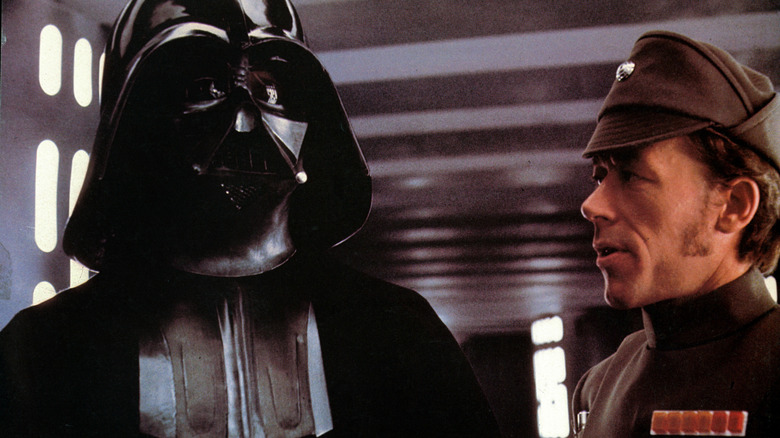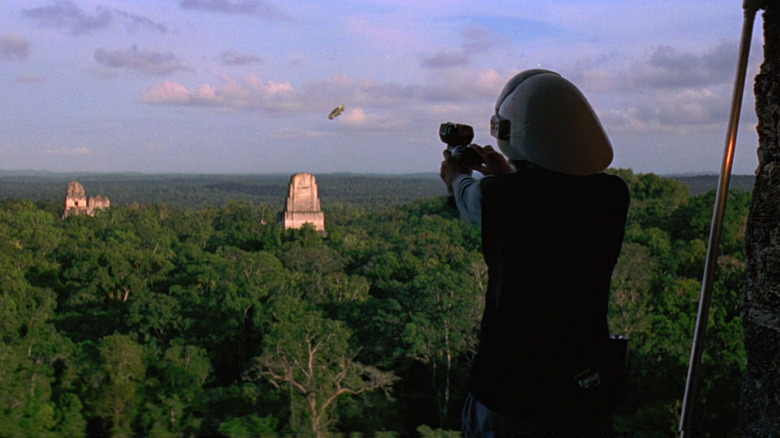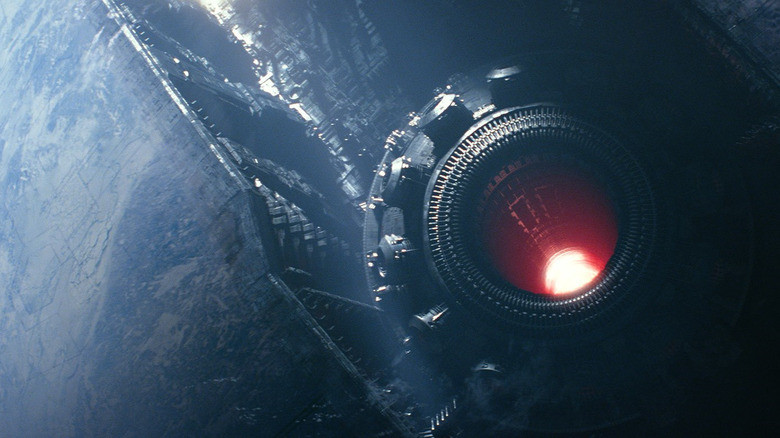Here's What ABY Means In The Star Wars Universe
George Lucas' 1977 film "Star Wars" takes place, as the opening chyron informs audiences, "A long time ago, in a galaxy far, far away." This phrase was meant to give the film a mythic, fairy tale feeling, letting audiences know that this was all ancient history, coming from a time of magic and wonderment. "Star Wars" is more about mythology and antediluvian, bardic storytelling than technology. This was not an aspirational future like "Star Trek," but an opera of the heroic past. One might pause to note that Lucas has never made a film set in the present, and the one film he made that was set in the future, "THX-1138," is bleak and pessimistic. Clearly, for Lucas, the past is a more comforting place than the present.
Of course, after Starwoids watched "Star Wars" hundreds of times on home video, some pesky technical questions about the makeup of the naturally began to arise. For instance, are the human-resembling characters humans? If they're from a distant galaxy, they are clearly some other species. And if that's the case, what is the name of their species? Or, if they are humans — as they are actually called throughout "Star Wars" — wouldn't they eventually travel to the Milky Way galaxy and populate Earth?
This then begs the question of when "a long time ago" is in years. And, wait, when "Star Wars" characters say "year," surely they don't mean "Earth year." Is a "Star Wars" year also 365 24-hour days?
In the franchise's expanded universe, years are merely recorded as being BBY or ABY, and even those designations didn't appear until "Star Wars" was 17 years old. There is a lot to explore when it comes to the universe's calendar-making. Let us delve into "Star Wars" time-mapping practices.
BBY and ABY
According to Bill Slavicsek's indispensable 1994 sourcebook "A Guide to the Star Wars Universe," BBY and ABY stand for Before the Battle of Yavin and After the Battle of Yavin. Said battle was evidently such a significant event in the world of "Star Wars" that the citizen crafted their own calendar around it. The Battle of Yavin, for "Star Wars" laypeople, is the climax of the 1977 film when Luke Skywalker (Mark Hamill) blew up the Death Star.
The Battle of Yavin dating standard was put into place before George Lucas began his work on "Star Wars: Episode I – The Phantom Menace," so the year designation became very handy for nailing down exactly when events took place in "Star Wars" history. Fans soon began to extrapolate from the Battle of Yavin, and found that "Menace" took place in 32 BBY. The Clone Wars took place from 22 to 19 BBY. The mythic Old Republic was a massive extended period that spanned 25,000 BBY up to 1,000 BBY. The events of "Star Wars: The Rise of Skywalker," meanwhile, took place in 35 ABY. It's an easy system to remember, as the original "Star Wars" film is the turning point.
And, yes, by the rule of extended "Star Wars" lore, years are exactly equal to Earth years. The "Star Wars" universe based its hours and days on the movement of the city-planet Coruscant, which just happens to have 24-hour days and 365-day years. Also, the human-looking characters age like humans, so if someone says they're 35, then they're 35. This is convenient for audiences, but galling to technically-minded science nerds.
But the BBY/ABY system was used for tracking time in "Star Wars" before Disney bought the property and excised a lot of the extant expanded universe lore.
BSI and ASI
Most fans still refer to BBY and ABY, but there is also a newer, less regarded BSI/ASI system.
BSI stands for Before Starkiller Incident, and ASI stands for After Starkiller Incident. The Starkiller Incident was when the First Order's Starkiller Base was blown up by the Resistance during the events of the 2015 film "Star Wars: The Force Awakens." That film previously took place in 34 ABY, but it seems Disney wants it to be the new fulcrum point for the entire franchise. By that estimation, "Star Wars" took place in 34 BSI, and "The Phantom Menace" in 66 BSI.
I have met no "Star Wars" fans who abide by the latter system. The former, meanwhile, is largely only traded in expanded universe lore. It has been mentioned as the canonical dating system in sources like 2014's "Star Wars Workbook: 2nd Grade Reading."
More than numbered years, though, history in "Star Wars" is more often measured in epochs. A handy article by Collider once laid them all out. The Dawn of the Jedi was 25,000 BBY, while the oft-referred to Old Republic was about 4,000 BBY. The High Republic era was about a century prior to "The Phantom Menace," and the prequel films of 1999 to 2005 were part of the Fall of the Jedi. The span in between "Revenge of the Sith" and "Star Wars" is called the Reign of the Empire, and the original "Star Wars" movies were the Age of the Rebellion. What followed was a brief era of the New Republic, which gave way to the Rise of the First Order, seen prior to the Disney-era sequel films. By the end of "The Rise of Skywalker," we had entered the New Jedi Order.
Everything clear? Good. Now gimme five.


